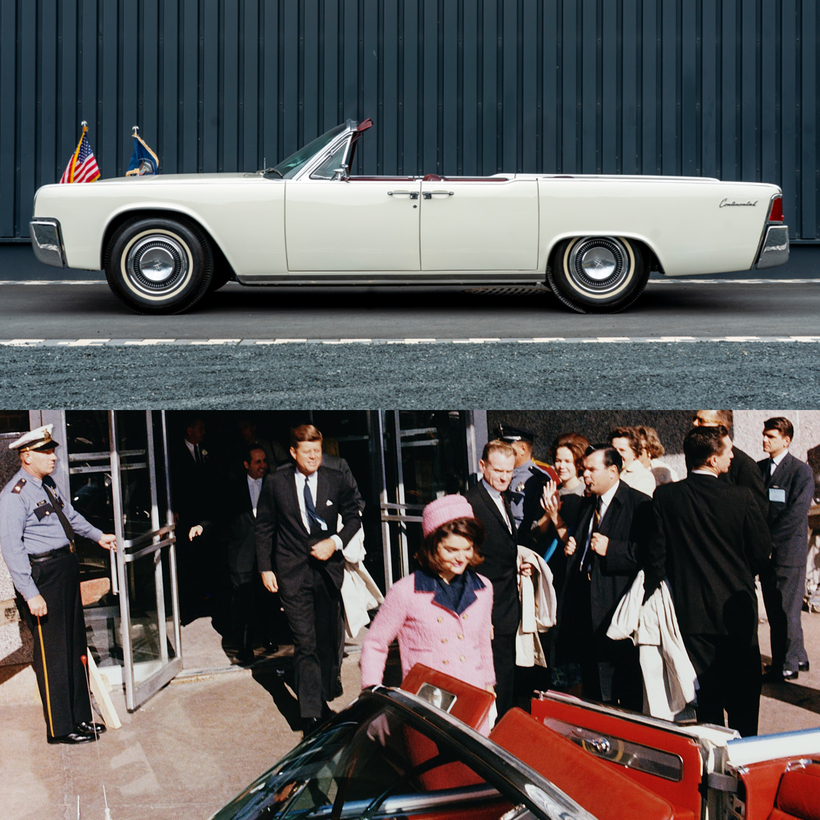Everyone remembers the dark-blue Lincoln Continental limousine in which John F. Kennedy was shot in Dallas on November 22, 1963. It is arguably the most well-known car in history. But here’s a question for experts on J.F.K.’s assassination: What was the last automobile from which the president stepped out alive that day?
It was, in fact, a white, open-topped Lincoln that Kennedy, the First Lady, and Texas governor John Connally rode in that morning. They rode in a motorcade from a breakfast speech at the Hotel Texas through Fort Worth, and then on to Carswell Air Force Base to make the short, fateful flight on Air Force One to Dallas.

The assassination car is preserved in the Henry Ford Museum of American Innovation, in Dearborn, Michigan, but it is barely recognizable. It was heavily modified and fortified after the shooting, and, as it was only three years old, it continued to be used by Presidents Johnson, Nixon, Ford, and Carter until it was retired, in 1977. The bullet-damaged windshield is held separately in the National Archives in Washington, D.C., along with Jackie Kennedy’s bloodstained pink Chanel suit. The latter cannot be displayed until 2103.
However, the car the presidential couple traveled in earlier on the last day of J.F.K.’s life has been preserved faithfully, with the red leather seating exactly as it was when the Kennedys arrived at the Air Force base.
This exceptionally poignant piece of American history has been through several private owners in the U.S., but in the past few months it has found a permanent home, on display at an auto museum in a small town in central Germany, an hour north of Frankfurt.

The Lincoln, with its original 1963 Texas license plates—EK 762—and almost nothing in the way of visible restoration, was bought over the phone in 2020 from a Bonhams auction in New York. The buyer, who successfully bid the reserve price of $375,000, was Friedhelm Loh, a German industrialist and private collector. Loh’s extraordinary menagerie of historic cars is valued at around $1 billion and was opened to the public last year in the village of Dietzhölztal-Ewersbach, having been officially named the Nationales Automuseum (German National Car Museum).
Even without the Kennedy car, the Loh collection is well worth any auto enthusiast’s time and the $19 cost of admission. It is one of the most expansive car museums in the world, with exhibits that straddle 135 years of auto history, from late-19th-century horse-carriage-like vehicles and quirky 20th-century European models to modern supercars by the dozen. One 1937 Bugatti alone, the Type 57 Atalante, is valued at upward of $10 million.

But more so than the 1920s Duesenbergs and NASCAR race cars, the Kennedy exhibit is making the museum consider opening a small hotel in the village. The curator who oversaw the purchase of the Lincoln, Tobias Reichle, says he bid on it because of the plan to open the Loh collection to the public. The Kennedy car would attract international, and particularly American, visitors.
“It has an amazing story behind it, which is what we always look for, but if we had remained a private collection, we may not have bid—although, of course, J.F.K. is a big thing in Germany too.” With Americans in mind, the museum has opened a New York–style deli, but there has already been a spike in international visitors from other countries, especially Japan and Australia.
The simple presentation of the Kennedy car—along with the incongruous setting, so far from both Texas and 1963—only enhances its impact. The white, horizontal slab just stands there, unadorned, with no barriers blocking it off and no hordes crowding round it. You can spend as long as you like imagining the scene in Fort Worth, and you can get within a few feet of the interior. The slightly worn but still-plush leather seating is especially touching to see in conjunction with a photo of the president just hours before he was killed, sitting on the right-hand side of the back seat and smiling broadly at Governor Connally.

The car’s provenance paperwork, which came with it from New York, explains some of its history in the intervening years. The Lincoln’s owner before it went to Germany is not revealed, but it was originally loaned to the Secret Service for the Fort Worth motorcade by a local used-auto dealer, Bill Golightly. In November 1964, Golightly sold it to a David Pelham, of Dallas. At the time, the Lincoln had locally been nicknamed “Limo One.” It was subsequently sold to other private collectors.
Scott Barker, a historian who researched the car when it came up for sale previously, in 2013, discovered that when it was returned to Golightly, the metal above the front wheel wells had marks from the thumbscrews that were used to fasten an American flag and presidential seal.

In a 2013 Boston auction, “Camelot: Fifty Years After Dallas,” the Lincoln attracted the highest bid out of hundreds of J.F.K.-related items. It sold for $318,000, beating Kennedy’s gold presidential ring, his rosary, Lee Harvey Oswald’s wedding band, and a window taken from the sixth floor of the Texas School Book Depository, from which Kennedy was shot.
Now, some 60 years after Kennedy’s assassination and halfway around the globe, the Lincoln is a reminder that although much of the world still looks to America as a symbol of progress, it sees an altogether different country now.
Based in London and New York, AIR MAIL’s tech columnist, Jonathan Margolis, spent more than two decades as a technology writer at the Financial Times. He is also the author of A Brief History of Tomorrow, a book on the history of futurology


